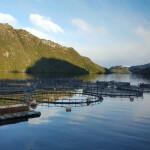As China celebrates the lunar New Year, a clamp down on official corruption has cut spending on high-end seafood like sea cucumber, shark fin and grouper. But there’s been a surge in demand from mid-tiered restaurants aimed at the country’s white collar and young professional classes.
CNY 2,888 (USD 476, EUR 323) seems the lucky number in Beijing this Chinese New Year’s eve. That’s the figure that most upscale hotels and restaurants are charging per table to those dining out to welcome in the New Year. At CNY 288 (USD 47, EUR 35) per person (each table seats 10) that's a comparatively good value deal in a Beijing five-star eatery. Prices have eased but seafood remains a major draw for families and couples flocked to the banqueting rooms at Choy Seafood, a Cantonese-themed restaurant at the Beijing Marriott Hotel Northeast. Another high-end hotel, the Grand Mercure is offering a similar 10-person table deal ranging from CNY 2,888 to CNY 4,888 (USD 806, EUR 597) per table. Offerings are similar in both hotels: lobster, oysters, Mandarin fish and shrimp.
In line with an official crack down on Communist Party corruption, there’s been a marked expansion in China's restaurant chains serving middle-income, non-government clientele. Malls and commercial properties have been keen to attract established chains like the Yun Hai Yao and Hui Lao Shan: the former has opened in the nominally upscale Galleries Lafayette. Cantonese-style Hui Lao Shan has opened in the Beijing Solana mall and in the Jinyu Plaza mall built by Vanke, one of China’s largest property development firms. The Hui Lao Shan chain is known for a squid curry and its crab cakes and shrimp dim sum delicacies.
“Before they all sought luxury brands but now malls are keen to sign up restaurants as tenants and to get a better tenant mix…similarly there are many stories of high end hotels seeking to down grade their star rating in order to be able to accommodate government banquets,” Marcos Chan, head of the north China commercial property portfolio at property advisory Jones Lang LaSalle told SeafoodSource.
A highly publicized freeze on banquets in government bodies and companies has dampened spirits and done away with the lavish banquets long beloved of officialdom in China, but there’s plenty of demand for seafood from the middle classes and among Chinese families who typically dine together at home on the eve of the New Year and then in the rest of the week-long holiday they take family members to restaurants.
Buying his dinner in a down-home dumpling shop won Xi Jinping plaudits. The stunt appeared copied from Obama’s playbook. But it also stressed his crackdown on lavish official dining. Much has been made in the Chinese media of the closure of high-end restaurants favored by Communist Party officials, military brass and businessmen.
Yet Beijing’s restaurant scene continues to thrive, and seafood remains a top draw. Newly opened Koyama in the Taikoo Li mall offers Japanese favorites like eel-tempura shrimp and fried octopus balls at CNY 50 (USD 8.25, EUR 6.11) and CNY 45 (USD 7.42, EUR 5.50) — middle class rates. Beijing restaurant critic Dong Xi Yi, whose microblog is closely followed by diners and restaurateurs, explained trends to SeafoodSource: “There’s more and more restaurants as Chinese people go abroad in bigger numbers and then also as foreigners come here for opportunities. We had a surge of Spanish restaurants when Spain was in crisis and Spaniards were looking for new markets.”
Sushi and sashimi remain favorites among local sophisticates, said Dong. Catering to local demand for sushi-style product, big name chef Max Levy has come from New York has opened his third Beijing sushi restaurant, OKRA, in the city’s flash “1949” complex. Line caught blackfin tuna CNY 150 (USD 25, EUR 18) (chunks of belly tuna) as well as yellow fin, scallops and sea bream. Seafood is a staple for famous chef Nobuyuki Matsuhisa at his Nobu restaurant in Beijing’s JW Marriott: rock shrimp, tempura and black cod miso are all on his menu.
Meanwhile, Yannicak Alleno has brought his Michelin starred Stay to the ShangriLa while another Michelin awardee, Danial Chambon serves up oysters at the French-themed Flo restaurant. On Chaoyangmenwai there’s shrimp al ajillio and squid ink paella at CNY 70 (USD 11.55, EUR 8.56) and CNY 190 (USD 31.35, EUR 23.22). Alaska crab and wild U.S. scallop are served at the Steak Exchange (serving more seafood lasagna and lobster on its menu than steak filets) at the Beijing Intercontinental.
Traditional upscale seafood restaurants meanwhile are clearly seeking to adapt. Formerly a favorite of local officials, the Seafood Garden (operated by Grand Mansion Restaurant Management Co) has adjusted by discounting lunches by 50 percent and hiring a Hong Kong marketing manager to reach out to the tourist trade. It’s still selling CNY 498 (USD 82, EUR 61) per 500 grams grouper and geoduck but staff emphasized to Seafoodsource how it’s also offering CNY 19 (USD 3,14, EUR 2.32) clams and French oysters at CNY 58 (USD 9.57, EUR 7.10). A CNY 50 value lunch box is a recent offering also at the Seafood Gardenwhich operates six outlets in Beijing, two in Shanghai.






